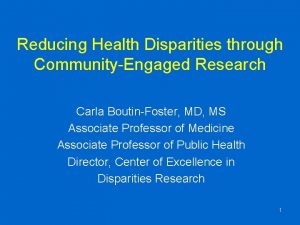Healthcare and Hispanics The Disparity in Healthcare Coverage

- Slides: 1

Healthcare and Hispanics: The Disparity in Healthcare Coverage and Affordability Between Genders Alexandra Acosta, Kevin Gajjar, Erik Rodriguez & Dr. Monica Escaleras College of Business: Economics Hispanics Overall Healthcare Affordability in 2014 Gender affordability Hispanics Graph Healthcare Affordability by Gender in 2014 Data and Methodology d • First, we used two primary research strategies to collect our data: (1) Telephone and (2) online surveys. We then developed a conceptual framework to test our hypotheses in the dissimilarity in healthcare coverage and affordability among Hispanics males and females 15% Harder Hasn’t change 43% 42% • Second, we collected a sample that consisted of 500 completed surveys from the national Hispanic population and analyzed it using IBM’s statistical package for social Science (SPSS) 46. 6% 43. 4% 42. 8% 37. 0% • 19. 6% Easier s 10. 6% Harder Hasn’t Changed Male Graph 1 Easier Female Graph 2 Hispanics Healthcare Coverage by Graph Gender coverage Gender in 2014 Graph of overall healthcare coverage Hispanics Overall Healthcare Coverage in 2014 63. 6% 53. 0% Government Coverage 26% 58% No Health Insurance 26. 5% 26. 1% 20. 8% 9. 8% Private Coverage Graph 3 Government Coverage Male Female Results and Discussion d • Based on our results, 19. 6% of Hispanic males find it easier to afford healthcare insurance while only 10. 6% of women find healthcare more affordable (Graph 2). Thus, there is a statistically significant difference in level of healthcare affordability between Hispanic males and females, where χ2 (2, n=529), p<0. 01. This is a small but statistically significant association where Phi = 0. 14…………………. . • Based on our results, 9. 8% of Hispanic males are without healthcare coverage, whereas for Hispanic women 20. 8% lack healthcare coverage (Graph 4). As a result, there is a statistically significant difference in level of healthcare coverage between Hispanic males and females, where χ2 (2, n=528), p<0. 01. This is a minor but statistically significant association where Phi = 0. 14 15% Private Coverage d No Health Insurance Graph 4 • Our results show that the number of Hispanics without healthcare insurance has decreased since the Affordable Care Act has been into effect. However, there still exists a gender inequality in the healthcare coverage and affordability. Perhaps additional policies are needed to close the gender gap References • Doty, M. , Rasmussen, P. , & Collins, S. (2014, September 25). Catching Up: Latino Health Coverage Gains and Challenges Under the Affordable Care Act.

